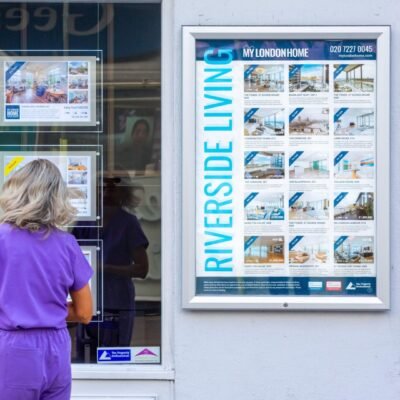Huell Whitehaus and his wife were newly married, recently out of graduate school and finally in jobs where they felt they could start saving up. It was 2020, and homeownership seemed within reach.
Four years later, the plan is on hold. The couple, now in their early 30s, had hoped to buy their first home before starting a family, but high interest rates and the ever-shrinking number of options within their price range have changed the math.
“We had a conversation two days ago,” he said. “If we just keep waiting around to have a kid until we can afford a house, I’ll be retired at that point.”
For many like Whitehaus and his wife trying to buy their first home, it’s begun to seem like a race against rising costs.
High housing costs have tormented new buyers in the Portland region for years, but the rise of mortgage rates to their current perch near 7% and a median home price of $535,000, according to the listing service RMLS, have pushed the region into record levels of unaffordability.
In December, the average Portland-area household could only afford 83% of a monthly payment on the average home, and that assumes they have enough for 20% down payment of more than $100,000.
Many in the new generation of homebuyers — millennials are now the largest cohort of prospective buyers, with some in Gen Z approaching prime home-buying years — are saddled with heavy loads of student debt that add to their challenge. And the alternative to homeownership is to continue paying rents that, some recent relief across the Portland area notwithstanding, seem only to climb.
Whitehaus and his wife each earn more than the average Portlander, both have steady jobs, and they aren’t struggling to make ends meet. They feel lucky, Whitehaus said, but still frustrated that it seems not enough.
“We’re in this holding pattern where we can afford life, we’re doing well and saving toward a home we can hopefully purchase in the future,” he said. “But we don’t know when that will be. For the immediate future, we’re resigned to the fact that we’ll have to keep renting.”
Saving, but ‘outpaced’
Debra Neal, an agent with Windermere Real Estate who also teaches homebuying classes, said she noticed a slight slowdown in people signing up for the classes early in the year. She chalked it up to would-be buyers discouraged by high mortgage rates.
More recently, she said, some buyers have gotten over the shock. And she said some sellers, sensing a slower market, are making more concessions and setting more reasonable asking prices.
“I just feel that buyers are a little bit more optimistic now than when things took a turn,” she said. “This is giving people hope that, OK, I can do this. That dream isn’t all the way gone.”
Yet even those with reason to be optimistic — who aren’t saddled with debt and have income to save — are struggling.
Thanks to a full scholarship, Cristian Ramirez graduated from college debt-free in 2019 and immediately took a job as a financial analyst. At the time, saving a down payment for a house that cost below $400,000 seemed attainable.
Since the pandemic, he said, things have looked a lot different. Home prices spiked, and then mortgage rates followed suit as the Federal Reserve moved to tamp down on inflation.
Ramirez, 26, felt lucky to still be working and earning enough to save, but at the same time, his goals were growing less attainable.
“I quickly started realizing that for every dollar I was saving, it felt like home values were going up by $2,” he said. “I was definitely getting outpaced.”
Ramirez said looking back, the best thing he could have done would probably have been to just buy a house before the pandemic, when something more affordable would have been on the market.
Now, he’s torn between two less favorable options: downsize significantly or buy a home for a lower price but then spend heavily on repairs.
“In terms of valuation, I can’t see those 800 or 900 square foot homes growing at the same paces as others,” he said.
‘Foot in the door’
Some who have braved the challenging market acknowledge they’ve had to make major compromises along the way.
Nancy Mejia started looking for a home last fall with a clear vision of what she wanted: a price below $400,000, perhaps a place that needed some minor repairs but not major renovations.
She had hoped to find something in North Portland, where she grew up. High prices and property taxes ruled that area out for her.
But Mejia, who is Latina, said she viewed buying a house as critical to building generational wealth that had been denied prior generations of Black and Latino residents through racist practices like redlining and predatory lending.
“No matter what,” she said, “I was not going back to renting.”
Taking financial education classes and working with a housing counselor from the Portland Housing Center, she found some options in Southeast Portland that did fit her budget, closing on a home last December.
It’s not perfect, she said, but she realized it was more important to start building equity than buy a “forever home” right off the bat.
“Programs like this can be used like stepping stones to purchase those forever homes,” she said. “We have to get our foot in the door.”
Jessenia Juarez is the home ownership program manager for the Portland Housing Center, which offers down payment assistance, mortgage lending and homebuyer education classes. She urged prospective buyers to seek out assistance before they give up on homeownership.
“Portland Housing Center has been able to create 347 homeowners since July, through down payment assistance programs,” Juarez said. “We need more, but that’s been bridging the gap for some clients.”
She said organizations like hers can help would-be homeowners better understand the homebuying process, and their own finances.
“Being able to make changes in your financial patterns and look at all of that holistically is super important,” Juarez said. “Not just the down payment aspect.”
Closing gaps
Alec Martinez and his wife were caught off guard earlier this year when their landlord’s real estate agent announced they wanted to list the home within just a few weeks.
Their landlord had mentioned last summer he was thinking of selling the place. The couple began examining their own finances to see if they could put in an offer when the home eventually went on the market.
They wanted to stay put. The couple lives with and cares for Martinez’s mother-in-law, who has developmental disabilities.
“We wanted to be close to the store because she goes on daily walks to the store. We wanted to be close to transit because she knows transit like the back of her hand,” said Martinez, 28.
But they hadn’t expected the day would come so soon.
“That was a really scary place to be,” he said. “We had to look at the market and try to figure out, are we even going to buy right now? We were looking at houses, we were looking at rentals, while still negotiating with our landlord about how much he was asking for.”
The landlord planned to sell the home for $600,000, but Martinez and his wife could only qualify for a loan sufficient for a $500,000 home.
But they found ways to narrow the gap. Martinez’s mother-in-law’s disability payments could qualify as income. The landlord agreed to drop the price.
Their monthly costs ballooned. As renters they paid $2,700 a month. With their mortgage rate of about 6.3%, their monthly payment is above $4,000.
While they’re thrilled to be able to stay, it’s not lost on Martinez how difficult the path to home ownership can be — or how important it is.
“If we want to build that future wealth, it’s still really tied to home ownership,” he said.
—Jayati Ramakrishnan reports on Oregonians’ access to housing, transportation and mental health care. Reach her at jramakrishnan@oregonian.com.
Our journalism needs your support. Subscribe today.





